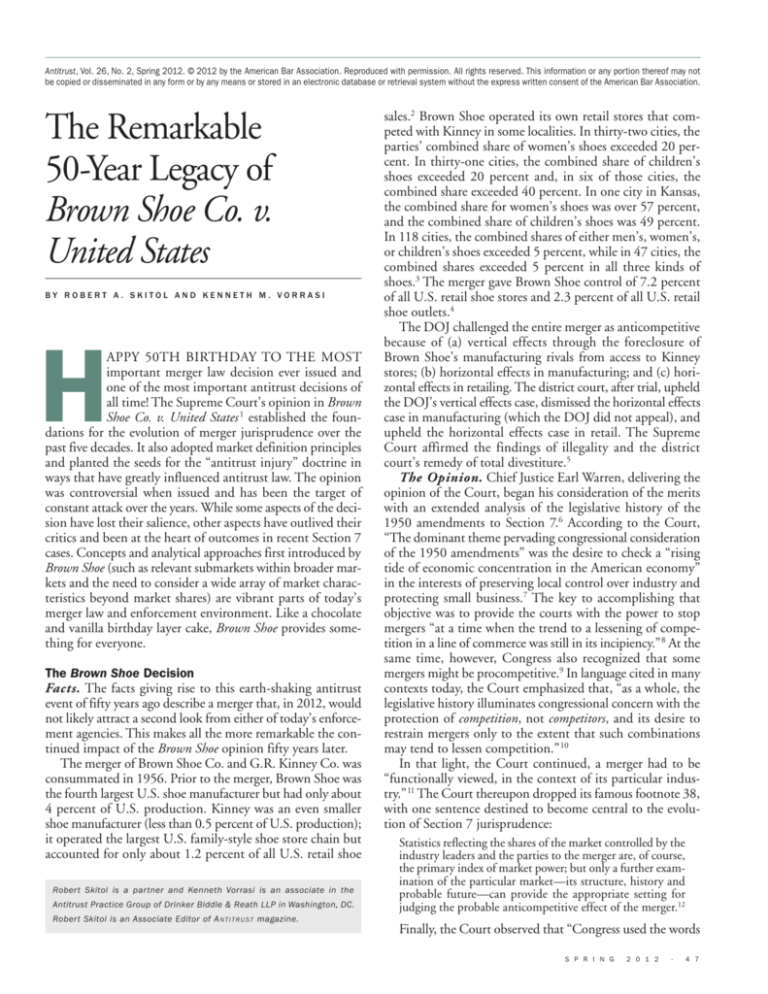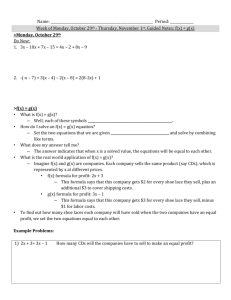
Antitrust, Vol. 26, No. 2, Spring 2012. © 2012 by the American Bar Association. Reproduced with permission. All rights reserved. This information or any portion thereof may not
be copied or disseminated in any form or by any means or stored in an electronic database or retrieval system without the express written consent of the American Bar Association.
The Remarkable
50-Year Legacy of
Brown Shoe Co. v.
United States
BY ROBERT A. SKITOL AND KENNETH M. VORRASI
H
APPY 50TH BIRTHDAY TO THE MOST
important merger law decision ever issued and
one of the most important antitrust decisions of
all time! The Supreme Court’s opinion in Brown
Shoe Co. v. United States 1 established the foundations for the evolution of merger jurisprudence over the
past five decades. It also adopted market definition principles
and planted the seeds for the “antitrust injury” doctrine in
ways that have greatly influenced antitrust law. The opinion
was controversial when issued and has been the target of
constant attack over the years. While some aspects of the decision have lost their salience, other aspects have outlived their
critics and been at the heart of outcomes in recent Section 7
cases. Concepts and analytical approaches first introduced by
Brown Shoe (such as relevant submarkets within broader markets and the need to consider a wide array of market characteristics beyond market shares) are vibrant parts of today’s
merger law and enforcement environment. Like a chocolate
and vanilla birthday layer cake, Brown Shoe provides something for everyone.
The Brown Shoe Decision
Facts. The facts giving rise to this earth-shaking antitrust
event of fifty years ago describe a merger that, in 2012, would
not likely attract a second look from either of today’s enforcement agencies. This makes all the more remarkable the continued impact of the Brown Shoe opinion fifty years later.
The merger of Brown Shoe Co. and G.R. Kinney Co. was
consummated in 1956. Prior to the merger, Brown Shoe was
the fourth largest U.S. shoe manufacturer but had only about
4 percent of U.S. production. Kinney was an even smaller
shoe manufacturer (less than 0.5 percent of U.S. production);
it operated the largest U.S. family-style shoe store chain but
accounted for only about 1.2 percent of all U.S. retail shoe
Robert Skitol is a partner and Kenneth Vorrasi is an associate in the
Antitrust Practice Group of Drinker Biddle & Reath LLP in Washington, DC.
Robert Skitol is an Associate Editor of A N T I T R U S T magazine.
sales.2 Brown Shoe operated its own retail stores that competed with Kinney in some localities. In thirty-two cities, the
parties’ combined share of women’s shoes exceeded 20 percent. In thirty-one cities, the combined share of children’s
shoes exceeded 20 percent and, in six of those cities, the
combined share exceeded 40 percent. In one city in Kansas,
the combined share for women’s shoes was over 57 percent,
and the combined share of children’s shoes was 49 percent.
In 118 cities, the combined shares of either men’s, women’s,
or children’s shoes exceeded 5 percent, while in 47 cities, the
combined shares exceeded 5 percent in all three kinds of
shoes.3 The merger gave Brown Shoe control of 7.2 percent
of all U.S. retail shoe stores and 2.3 percent of all U.S. retail
shoe outlets.4
The DOJ challenged the entire merger as anticompetitive
because of (a) vertical effects through the foreclosure of
Brown Shoe’s manufacturing rivals from access to Kinney
stores; (b) horizontal effects in manufacturing; and (c) horizontal effects in retailing. The district court, after trial, upheld
the DOJ’s vertical effects case, dismissed the horizontal effects
case in manufacturing (which the DOJ did not appeal), and
upheld the horizontal effects case in retail. The Supreme
Court affirmed the findings of illegality and the district
court’s remedy of total divestiture.5
The Opinion. Chief Justice Earl Warren, delivering the
opinion of the Court, began his consideration of the merits
with an extended analysis of the legislative history of the
1950 amendments to Section 7.6 According to the Court,
“The dominant theme pervading congressional consideration
of the 1950 amendments” was the desire to check a “rising
tide of economic concentration in the American economy”
in the interests of preserving local control over industry and
protecting small business.7 The key to accomplishing that
objective was to provide the courts with the power to stop
mergers “at a time when the trend to a lessening of competition in a line of commerce was still in its incipiency.” 8 At the
same time, however, Congress also recognized that some
mergers might be procompetitive.9 In language cited in many
contexts today, the Court emphasized that, “as a whole, the
legislative history illuminates congressional concern with the
protection of competition, not competitors, and its desire to
restrain mergers only to the extent that such combinations
may tend to lessen competition.” 10
In that light, the Court continued, a merger had to be
“functionally viewed, in the context of its particular industry.” 11 The Court thereupon dropped its famous footnote 38,
with one sentence destined to become central to the evolution of Section 7 jurisprudence:
Statistics reflecting the shares of the market controlled by the
industry leaders and the parties to the merger are, of course,
the primary index of market power; but only a further examination of the particular market—its structure, history and
probable future—can provide the appropriate setting for
judging the probable anticompetitive effect of the merger.12
Finally, the Court observed that “Congress used the words
S P R I N G
2 0 1 2
·
4 7
‘may be substantially to lessen competition’ to indicate that
its concern was with probabilities, not certainties.” 13 In short,
the amended Section 7 was addressed neither to “clear-cut
menaces” nor to “ephemeral possibilities”; the focus was
“probable anticompetitive effect . . . .” 14
Vertical Effects. The Court began its consideration of
the vertical aspects of the Brown/Kinney merger with the
observation that the “primary vice of a vertical merger . . . is
that, by foreclosing the competitors of either party from a segment of the market otherwise open to them, the arrangement
may act as a ‘clog on competition’” 15 and deprive “rivals of
a fair opportunity to compete.”’ 16 But since the law forbids
only mergers whose effect may be substantially to lessen competition within a particular line of commerce and section of
the country, a determination of the relevant product and
geographic market is a “necessary predicate” to finding a
violation.17 The Court thereupon set forth the standards for
product market definition—crucially including “submarket”
analysis—as follows:
The outer boundaries of a product market are determined by
the reasonable interchangeability of use or the cross-elasticity of demand between the product itself and substitutes for
it. However, within this broad market, well-defined submarkets may exist which, in themselves, constitute product
markets for antitrust purposes. . . . The boundaries of such
a submarket may be determined by examining such practical indicia as industry or public recognition of the submarket as a separate economic entity, the product’s peculiar characteristics and uses, unique production facilities, distinct
customers, distinct prices, sensitivity to price changes, and
specialized vendors. Because [Section 7 prohibits any merger that may substantially lessen competition in “any” line of
commerce], it is necessary to examine the effects of a merger in each such economically significant submarket . . . .18
Applying those standards, the Court upheld the findings of
three relevant product markets for this case: men’s, women’s,
and children’s shoes.19 Separately, the Court endorsed findings
that, “insofar as the vertical aspect of this merger is concerned,
the relevant geographic market is the entire Nation.” 20
Next, in considering whether there was a “probable” anticompetitive effect from the vertical aspect of the merger at
issue, the Court observed that “an important consideration”
is “the size of the share of the market foreclosed.” 21 Where the
extent of foreclosure was “neither of monopoly nor de minimis proportions,” other factors must be considered. Here,
given Brown’s place as the nation’s fourth largest manufacturer in the shoe industry and Kinney’s as the nation’s largest
independent chain of family shoe stores, “no merger between
a manufacturer and an independent retailer could involve a
larger potential market foreclosure.” 22
The Court’s vertical effects analysis and conclusion were
expressly influenced by its focus upon Congressional interest
in avoiding “adverse effects upon local control of industry
and upon small business.” 23 In this “populist” light, the
industry trends toward both increased concentration and
vertical integration were critical facts which, “when com4 8
·
A N T I T R U S T
Photo: SuperStock
A R T I C L E S
bined with Brown’s avowed policy of forcing its own shoes
upon its retail subsidiaries, may foreclose competition from
a substantial share of the markets for men’s, women’s, and
children’s shoes without producing any countervailing competitive, economic, or social advantages.” 24
Horizontal Effects. With respect to the horizontal case
in shoe retailing,25 the Court again deemed market definition
a “necessary predicate” to an examination of competitive
effects and held that the same three lines of commerce used
for assessing the vertical aspects—men’s, women’s and children’s shoes—were relevant product markets for the horizontal aspects of the merger as well.26
Geographic market definition, however, took a different
turn. For the vertical aspects, the geographic market was the
nation as a whole; for the horizontal retail analysis, the focus
became submarkets consisting of “those cities with a population exceeding 10,000 and their environs in which both
Brown and Kinney retailed shoes through their own outlets.” 27 This was the result of the Court’s application of what
it deemed a Congressional prescription of “a pragmatic, factual approach to the definition of relevant market”––requiring geographic market determination to “correspond to the
commercial realities” of the industry at issue and “be economically significant.” 28
As indicated above, combined market shares varied considerably among various groups of cities for which evidence
was presented.29 The Court chose, however, to underline the
significance of overlaps within 118 cities where combined
shares exceeded 5 percent:
If a merger achieving 5% control were now approved, we
might be required to approve future merger efforts by
Brown’s competitors seeking similar market shares. The oligopoly Congress sought to avoid would then be furthered
and it would be difficult to dissolve the combinations previously approved. Furthermore, in this fragmented industry,
even if the combination controls but a small share of a particular market, the fact that the share is held by a large
national chain can adversely affect competition.30
The Court acknowledged that the Act protects “competition, not competitors,” and thus “large integrated or chain
operations” (like the merged Brown enterprise) are “not
rendered unlawful by the mere fact that small independent
stores may be adversely affected.” 31 The “but” coming after
that acknowledgment, however, became a repeated target of
attack upon the entire Brown Shoe opinion over the ensuing
several decades, as it appears to elevate populist sentiments
over considerations of efficiency and consumer welfare:
But we cannot fail to recognize Congress’ desire to promote
competition through the protection of viable, small, locally
owned business. Congress appreciated that occasional higher costs and prices might result from the maintenance of
fragmented industries and markets. It resolved these competing considerations in favor of deconcentration. We must
give effect to that decision.32
The Court added that, by virtue of this merger, “the largest
single group of retail stores still independent of one of the
large manufacturers was absorbed into an already substantial
aggregation”; “Brown moved into second place nationally in
terms of retail stores directly owned”; Brown thereby came to
control about 7.2 percent of the nation’s retail shoe stores and
2.3 percent of the nation’s total retail shoe outlets.33 “We
cannot avoid the mandate of Congress that tendencies toward
concentration in industry are to be curbed in their incipiency”; so, “[i]n the light of the trends in this industry we agree
with the Government and the court below that this is an
appropriate place at which to call a halt.” 34
Early Reactions
The business community was not pleased. The June 30,
1962, edition of Business Week complained that the decision
“gave the broadest possible interpretation to the 1950
amendments to the Clayton Act”; “gave the trustbusters a
powerful weapon by upholding a liberal interpretation of
‘line of commerce’”; endorsed the theory that industries
“made up of many competitors should be kept in this condition” by stopping any merger therein even if its effect on
competition “is slight”; and, as a result, “there is a serious
question . . . as to whether any mergers at all can now hope
to escape the heavy hand of the Justice Department.” 35 The
December 1963 edition of Fortune published a scathing critique by Robert Bork and Ward Bowman, in which they concluded that the decision
employed the theory of exclusionary practices to outlaw vertical integration that promised lower prices, the theory of
incipiency to foresee danger in a presumably desirable trend
that was barely started, and the theory of “social purpose” to
justify the fact that it prevented the realization of efficiencies
by a merger that, realistically viewed, did not even remotely
threaten competition.36
On the other hand, there was high praise from other
quarters. The esteemed Milton Handler emphasized that,
although the Court invalidated both the vertical and horizontal aspects of the merger at issue, “it did not do so on the
sweeping terms employed” by the lower court. The Government was “rebuffed in its efforts to convert Section 7 into a
per se statute”; the Court served notice that every merger is
unique, requiring that it be “functionally viewed, in the context of its particular industry”; and “[w]hen a particular
merger is challenged, there are no facile shortcuts to the necessary factual determination of whether the challenged acquisition is reasonably likely to have the requisite anticompetitive effects in the relevant market.” 37 In short, the Court
stopped the government’s “crusade to have merger litigation
decided on the basis of naked statistics” and established the
requirement to “evaluate each merger in terms of its peculiar
facts in order to predict its probable competitive impact.” 38
Two young associates destined to become prominent
members of the antitrust community, William Rogers and
Sanford Litvack, presciently argued in 1963 that the most significant aspect of the decision may end up being footnote 65
and the language in text giving rise to it.39 More specifically,
the Court there observed that the fact that merging firms
have competed in but a fraction of the geographic markets in
which either has operated “does not, in itself, place their
merger outside the scope of § 7” because “if anti-competitive
effects of a merger are probable in ‘any’ significant market,
the merger––at least to that extent––is proscribed.”40 Footnote 65 illustrated as follows:
If two retailers, one operating primarily in the eastern half of
the Nation, and the other operating largely in the West,
competed in but two mid-Western cities, the fact that the latter outlets represented but a small share of each company’s
business would not immunize the merger in those markets .
. . . On the other hand, that fact would, of course, be properly considered in determining the equitable relief to be
decreed.41
Rogers’s and Litvack’s key insight about that footnote was its
invitation to “partial divestiture” as a means of addressing
anticompetitive effect in part of a transaction while enabling
the rest of the transaction to proceed ahead. In short, the
Court suggested “a means whereby the skillful attorney may
either be able to transform an otherwise illegal merger into
one which would not violate Section 7 and avoid suit or, once
suit has been commenced, effectuate a settlement which will
not require total and complete divestiture.” 42 Of course, that
scenario captures the essence of merger enforcement policy as
it has evolved since at least the late 1970s to our day: the great
majority of all government merger challenges are addressed
through surgically negotiated divestiture orders allowing consummation of the bulk of the transactions at issue.
From Brown Shoe to the Baxter Merger Guidelines
There were two sharply conflicting themes at play in the
Brown Shoe opinion: a populist emphasis on preserving fragmentation, local control, small business, etc., and a consumer welfare emphasis on protecting “competition, not
competitors.” The populist theme prevailed throughout the
1960s as Brown Shoe pushed the evolution of Section 7
jurisprudence in the direction of deeper reliance upon market share data,43 gerrymandering on submarket definitions 44
and resulting condemnations of mergers that could not be
seen as threatening “competition” in any meaningful sense.45
By 1966, dissenting Justice Stewart was pushed to complain
that “[t]he sole consistency” in Section 7 litigation is that “the
Government always wins.” 46
That is, until 1974 when the Government lost three Section 7 cases before the Supreme Court.47 The most important
of the decisions in those cases was United States v. General
S P R I N G
2 0 1 2
·
4 9
A R T I C L E S
Dynamics Corp.48 In an opinion by Justice Stewart, the Court
upheld the lower court’s dismissal of the Government’s challenge to a merger between two competing coal companies
with market share and concentration effects recognized as sufficient to condemn the transaction under Brown Shoe and its
1960s progeny. The core explanation for the Court’s rejection
of the Government’s challenge was the Court’s elevation
from footnote dictum to central tenet of the following language from Brown Shoe: while market share and concentration statistics are “the primary index of market power,” only
“a further examination of the particular market—its structure, history and probable future—can provide the appropriate setting for judging the probable anticompetitive effect
of the merger.” 49 The Court emphasized that “[e]vidence of
past production does not, as a matter of logic, necessarily give
a proper picture of a company’s future ability to compete.” 50
On the record before it, the lower court had found that the
acquired company’s current and future ability to compete for
long-term contracts was severely limited by its lack of uncommitted reserves. The Supreme Court agreed that this fact
precluded any finding of a probable anticompetitive effect
from the merger at issue.51
The General Dynamics decision became a critical turning
point in the evolution of Section 7 jurisprudence from a
populist to a consumer welfare orientation. Ten years later,
the General Dynamics insight—with its origin in a Brown
Shoe footnote—became an important part of the Baxter
DOJ’s Horizontal Merger Guidelines, specifically in its statement that the Department “will consider reasonably predictable effects of recent or on-going changes in market conditions in interpreting market concentration and market
share data.” 52 By way of example, “if a new technology that
is important to long-term competitive viability is not available to a particular firm, the Department may conclude that
the historical market share of the firm overstates the firm’s
future competitive significance.” 53 The Guidelines also recognized that effective pricing above competitive levels is less
likely if “technological change” in the industry is rapid.54
Other aspects of the Brown Shoe decision can be found
throughout the Baxter Guidelines. For example, one can reasonably characterize much of the modes of analysis for market definition as building upon the foundations for both
product and geographic market definitions set forth in the
Brown Shoe opinion.55 On the other hand, Assistant Attorney
General Baxter himself went out of his way to highlight his
decision to exclude from the Guidelines one major drumbeat
from Brown Shoe: “An industry trend toward concentration
is not a factor that will be considered, even though it has been
used in the past.” 56 More generally speaking, the Guidelines
were widely viewed as making a sharp break from Brown
Shoe thinking:
The new Guidelines are explicitly and unabashedly economic in approach . . . . [They] are directed at limiting the
opportunity for tacit collusion among participants in a market. The grander and more generalized concerns of the
5 0
·
A N T I T R U S T
past—viewing mergers as a threat to the societal fabric, for
example—have been discarded . . . . [T]he social and political content of antitrust is intellectually passe, the relic of
another era. . . . [S]ince Brown Shoe, populist concerns have
become largely vestigial. . . . The key populist phrases of the
Warren Court have been muffled.57
Brown Shoe Rebounds
Ten years later, Brown Shoe reemerged in a new role: a forceful constraint upon Section 7 enforcement activity. The precipitating cause was the 1992 promulgation of revised DOJFTC Horizontal Merger Guidelines containing a new section
on “Lessening of Competition through Unilateral Effects.” 58
This section appeared to invite challenges to mergers between
particularly “close” competitors within markets for differentiated products solely because that closeness enables the
merged firm to raise prices on one of the merging products
and without need to show an anticompetitive impact in “the
market” as a whole.59
Two district courts in 1993 rejected merger challenges
along those lines for failure to account for competition from
substitute products and thus failure to establish the “relevant”
product market in Brown Shoe terms.60 In United States v.
Gillette Co., the Antitrust Division argued that the merger
would lessen competition in a relevant market defined as
“premium refillable fountain pens”; the district court disagreed with that definition, finding that there was “ample evidence that the merged company will not be able to increase
prices on premium fountain pens unilaterally.” 61 And in
Pennsylvania v. Russell Stover Candies, Inc., the district court
rejected the Commonwealth of Pennsylvania’s two proffered
market definitions—(i) “branded gift box chocolates” sold at
drugstores and mass merchandisers and (ii) boxed chocolates—as too narrow in light of competitive conditions in the
chocolate industry.62
As one observer noted, those decisions were pointed
reminders that market definition “has been a ‘necessary predicate’ for any” Section 7 claim ever since Brown Shoe; the lesson from them was that “the more choices available to consumers in industries with differentiated products, the more
likely the market will be defined broadly or anticompetitive
effects will not be found”; and, most importantly, the Brown
Shoe prescription of “reasonable interchangeability remains
the guiding principle after all.” 63
By the latter part of that decade, however, the FTC discovered how a different aspect of the Brown Shoe discussion
of market definition standards could powerfully support unilateral effects challenges: the “submarket” concept as applied
to particularly close competition between parties within a
broader market. This was indeed the ground on which the
FTC persuaded courts to enjoin three mergers in the late
1990s. In FTC v. Staples, Inc., the Commission challenged the
merger of two leading office supplies superstores in 1997,
arguing that these firms competed most directly within a
submarket of office supplies superstores that sell consumable
office products.64 The district court agreed, relying on the
“practical indicia” set forth in Brown Shoe.65 Notably, the
court found that office superstores restrained one another’s
prices far more than other competing retailers that also sold
consumable office products.66
One year later, in 1998, the FTC challenged two mergers
that would combine the four leading drug wholesalers, in
FTC v. Cardinal Health, Inc.67 The court agreed with the
FTC’s proffered relevant product market of wholesale drug
distribution despite competition from other forms of drug
distribution, finding that wholesale drug distribution was a
“distinct submarket” within the “larger market of drug
delivery.” 68 And in 2000, the FTC sought to enjoin a merger between two leading loose leaf tobacco manufacturers,
despite competition from moist snuff tobacco product manufacturers, in FTC v. Swedish Match North America, Inc.69
Relying on Brown Shoe’s submarket construction, the court
agreed with the FTC that the relevant product market in
which to analyze the merger was loose leaf tobacco and not
all smokeless tobacco.70 It concluded: “While the Court
believes there is some degree of competition between, and
overlapping consumer usage of, moist snuff and loose leaf
tobacco, the weight of the evidence read in light of Brown
Shoe’s indicia convinces the Court that loose leaf chewing
tobacco constitutes a distinct relevant product market.” 71 As
one of us observed in 2001, the decisions in these cases
breathed “new life into the hoary and much-maligned ‘submarket’ doctrine emanating from” Brown Shoe; “submarket
is no longer a dirty word, and Brown Shoe indicia have come
back to respectability in merger law.” 72
Seven years later, the close affinity between unilateral
effects analysis and Brown Shoe submarket doctrine deepened all the more as the D.C. Circuit Court of Appeals
blessed the FTC’s challenge to the merger of Whole Foods
and Wild Oats for its impact upon a core group of supermarket customers who “decided that natural and organic is
important.” 73 Before endorsing the agency’s market definition of “premium natural and organic supermarkets,” however, the court of appeals observed that, “[i]nexplicably, the
FTC . . . asserts a market definition is not necessary in a § 7
case . . . in contravention of the statute itself.” 74 The FTC
suggested that market definition is just a “means to an end”
to “enable some measurement of market power”; but that is
“not the only purpose of a market definition” because “only
‘examination of the particular market—its structure, history[,] and probable future—can provide the appropriate setting for judging the probable anticompetitive effect of the
merger.’” 75
Center-Stage Today
Controversy over the continued relevance of Brown Shoe
pronouncements on market definition is at the heart of the
most important Section 7 developments of the past two
years. Alarm bells rang as the agencies rolled out the 2010 version of Horizontal Merger Guidelines,76 which were criticized
for downplaying or even “marginalizing” the role of market
definition in merger analysis and replacing adherence to the
established rule of reasonable interchangeability with a new
and untested focus upon “upper pricing pressure” upon one
or more of the merging parties’ products.77 Not so, according to the DOJ’s Acting Assistant Attorney General in a
November 2011 address: “We continue to apply traditional
merger analysis techniques to our matters,” exemplified by
the agency’s “successful challenge to the proposed merger
between H&R Block and Tax Act,” in which “the court
focused on product market definition.” 78
The opinion in the H&R Block case, issued one week
before those remarks, contained no less than nine citations to
Brown Shoe.79 In one robust footnote, the court acknowledged recent suggestions that, as a “‘matter of applied economics, evaluation of unilateral effects does not require a
market definition in the traditional sense at all’”; 80 responded that as “a legal matter, however, a market definition may
be required by Section 7,” 81 and noted it “is not aware of any
modern Section 7 case in which the court dispensed with the
requirement to define a relevant product market . . . .” 82 The
court in H&R Block went on to conclude, in reliance on
Brown Shoe, that digital do-it-yourself tax preparation is a relevant submarket distinct from assisted tax preparation by a
tax professional and manual or self tax preparation on penand-paper.83
Perhaps the most dramatic Section 7 development within the past year is the Eighth Circuit’s affirmance of a district
court’s dismissal of an FTC challenge to Lundbeck’s acquisition of NeoProfen, a drug for treatment of a heart condition in premature babies.84 Lundbeck already owned the only
other drug approved for that condition, Indocin IV. Two
days after the acquisition of NeoProfen, Lundbeck raised the
price of Indocin IV by 1300 percent.85 Despite that strong
and “direct” evidence of anticompetitive effect, the appeals
court upheld the district court’s finding that the two drugs
were not within the same market based on testimony to the
effect that there is very low cross-elasticity of demand or
price elasticity between them. 86 As highlighted by the
agency’s rehearing petition,87 an amicus brief in support of
it,88 and a separate statement issued by FTC Commissioner
J. Thomas Rosch,89 the court misread an “or” as if it were an
“and” in the following key passage from Brown Shoe: “The
outer boundaries of a product market are determined by the
reasonable interchangeability of use or the cross-elasticity of
demand between the product itself and substitutes for it.” 90
The result in Lundbeck was a complete disregard of interchangeability of use as a sufficient independent ground for
product market definition in the case at hand. Chief Justice
Warren would not be pleased.
On November 22, 2011, the Eighth Circuit denied the
rehearing petition.91 On January 20, 2012, the Commission
announced that it did not intend to seek review in the U.S.
Supreme Court despite agreeing with Commissioner Rosch
that “the result in this case was profoundly wrong . . . .” 92
Commissioner Rosch’s separate statement expressed chagrin
S P R I N G
2 0 1 2
·
5 1
A R T I C L E S
over missing this opportunity to enable the Court to clarify
what it said about market definition fifty years ago.93
* * * * *
Robert Pitofsky observed in 1985 that “[m]erger enforcement in the United States has often been erratic and always
controversial.” 94 As we have sought to illustrate in this article, the Supreme Court’s Brown Shoe opinion has contributed
more than its share—more than any other Section 7 development—to support both parts of that comment. Both erratic and controversial are apt descriptions for the huge swings
in merger enforcement outcomes from the Wild West of the
1960s to the more restrained 1970s and 1980s, the ups and
downs during the 1990s and 2000s, and today’s increasingly disciplined and sophisticated array of techniques available
to identify likely anticompetitive effects. Over this stretch,
Brown Shoe law has lost its original populist bent—protecting small business, local control, etc.—and matured into
wise, mainstream guiding principles up to the task of driving
the further evolution of merger law over the years ahead. So,
in this 50th anniversary year, liberals and conservatives,
Chicago and Post-Chicago denizens, everyone across the
noisy and disparate antitrust landscape can join hands in
this robust salute: Happy Birthday and Long Live Brown
Shoe! 䡵
that portion of the lower court’s decision. As the Supreme Court characterized the findings, “[T]he merger of Brown’s and Kinney’s manufacturing
facilities was economically too insignificant to come within the prohibitions
of the Clayton Act . . . .” Id. at 335 (emphasis added).
26
Id. at 335–36.
27
Id. at 339.
28
Id. at 336–37.
29
See supra text accompanying note 3.
30
Brown Shoe, 370 U.S. at 343–44.
31
Id. at 344.
32
Id.
33
Id. at 345–46.
34
Id. at 346.
35
B US . W K ., June 30, 1962, at 160.
36
Robert Bork & Ward Bowman, The Crisis in Antitrust, F ORTUNE , Dec. 1963,
at 197.
37
Milton Handler, Fifteenth Annual Review of Antitrust Developments 17 R ECORD
A SS ’ N B. C ITY OF NY 411, 433, 437 (1962).
38
Id. at 440.
39
William F. Rogers & Sanford M. Litvack, Brown Shoe: The Guidance of a
Footnote, 1963 WASH U. L.Q. 192, 193 (1963).
40
Brown Shoe, 370 U.S. at 337.
41
Id. at 337 n.65.
42
Rogers & Litvack, supra note 39, at 199.
43
See, e.g., United States v. Philadelphia Nat’l Bank, 374 U.S. 321 (1963).
44
See, e.g., United States v. Pabst Brewing Co., 384 U.S. 546 (1966).
45
See, e.g., United States v. Von’s Grocery Co., 384 U.S. 270 (1966).
46
Id. at 301.
47
See United States v. Gen. Dynamics Corp., 415 U.S. 486 (1974); United
States v. Marine Bancorporation, 418 U.S. 602 (1974); United States v.
Connecticut Nat’l Bank, 418 U.S. 656 (1974).
1
Brown Shoe Co. v. United States, 370 U.S. 294 (1962).
2
Id. at 298, 303.
3
Id. at 342–43.
48
General Dynamics, 415 U.S. 486 (1974).
4
Id. at 345.
49
Id. at 498 (quoting Brown Shoe, 370 U.S. at 322 n.38).
5
Id. at 304, 346.
50
Id. at 501.
6
See Celler-Kefauver Antimerger Act of 1950, Pub. L. No. 81-899, 64 Stat.
1125 (codified as amended at 15 U.S.C. § 18).
51
Id. at 503–04.
52
U.S. Dep’t of Justice, Merger Guidelines § 3.21 (1984) [hereinafter 1984
Merger Guidelines], available at http://www.justice.gov/atr/hmerger/
11249.pdf. The Baxter DOJ promulgated its first set of Merger Guidelines
in 1982.
7
Brown Shoe, 370 U.S. at 315–16.
8
Id. at 317.
9
Id. at 319.
10
Id. at 320.
53
Id.
11
Id. at 321–22.
54
Id. § 3.411 n.23.
12
Id. at 322 n.38.
55
13
Id. at 323.
See id. §§ 2.11, 2.12, 2.21 (product market principles); id. §§ 2.31, 2.32
(geographic market principles).
14
Id.
56
15
Id. at 323–24 (quoting Standard Oil Co. of Cal. v. United States, 337 U.S.
293, 314 (1949)).
William Baxter, Responding to the Reaction: The Draftsman’s View, 71 C ALIF.
L. R EV. 618, 630 (1983).
57
Donald I. Baker & William Blumenthal, The 1982 Guidelines and Preexisting
Law, 71 C ALIF. L. R EV. 311, 317–18, 320 (1983).
58
U.S. Dep’t of Justice & Fed. Trade Comm’n, Horizontal Merger Guidelines
§ 2.2 (1992), available at http://www.justice.gov/atr/public/guidelines/
hmg.pdf.
16
Id. at 324 (quoting H.R. R EP. No. 1191, 81st Cong., 1st Sess. 8).
17
Id. (quoting United States v. E.I. du Pont de Nemours & Co., 353 U.S. 586,
593 (1956)).
18
Id. at 325.
59
Id.
19
Id. at 326.
60
20
Id. at 328.
21
Id.
See United States v. Gillette Co., 828 F. Supp. 78 (D.D.C. 1993);
Pennsylvania v. Russell Stover Candies, Inc., No. 93-1972, 1993 WL
145264 (E.D. Pa. May 6, 1993).
22
Id. at 331–32.
61
See Gillette, 828 F. Supp. at 84.
23
Id. at 333.
62
See Russell Stover, 1993 WL 145264, at *10–11.
24
Id. at 334.
63
25
As indicated above, the lower court dismissed the DOJ’s challenge to the
horizontal overlap in shoe manufacturing, and the DOJ did not appeal from
James A. Keyte, Market Definition and Differentiated Products, A NTITRUST , Fall
1993, at 19, 22.
64
FTC v. Staples, Inc., 970 F. Supp. 1066, 1074 (D.D.C. 1997).
5 2
·
A N T I T R U S T
65
Id. at 1075 (discussing Brown Shoe, 370 U.S. at 325).
66
Id. at 1075–76.
67
FTC v. Cardinal Health, Inc., 12 F. Supp. 2d 34, 45 (D.D.C. 1998).
68
Id. at 47.
69
FTC v. Swedish Match No. Am., Inc., 131 F. Supp. 2d 151, 153–54 (D.D.C.
2000).
70
Id. at 156.
71
Id. at 165.
72
Robert A. Skitol, Merger Litigation in the Clinton Years: The Section 7
Jurisprudential Legacy, A NTITRUST R EP., Jan. 2001, at 9–10.
73
FTC v. Whole Foods Mkt., Inc., 548 F.3d 1028, 1039 (D.C. Cir. 2008).
74
Id. at 1036 (citing Brown Shoe, 370 U.S. at 324).
75
Id. (quoting Brown Shoe, 370 U.S. at 322 n.38).
76
See U.S. Dep’t of Justice & Fed. Trade Comm’n, Horizontal Merger
Guidelines (2010), available at http://www.justice.gov/atr/public/guide
lines/hmg-2010.pdf.
77
See, e.g., James A. Keyte & Kenneth B. Schwartz, “Tally-Ho!”: UPP and the
2010 Horizontal Merger Guidelines, 77 A NTITRUST L.J. 587, 588–94,
597–98, 600–04 (2011); Comments of the ABA Section of Antitrust Law on
the Proposed Revised DOJ-FTC Horizontal Merger Guidelines 6–8 (June 4,
2010), available at http://www.ftc.gov/os/comments/hmgrevised
guides/548050-00026.pdf; Comments of General Electric Company et al.
on the Proposed Revised DOJ-FTC Horizontal Merger Guidelines 11–12
(June 4, 2010), available at http://www.ftc.gov/os/comments/hmgrevised
guides/548050-00028.pdf; Comments of Verizon Communications, Inc.
et al. on the Proposed Revised DOJ-FTC Horizontal Merger Guidelines 2
(June 4, 2010), available at http://www.ftc.gov/os/comments/hmg
revisedguides/548050-00022.pdf.
78
Sharis A. Pozen, Acting Assistant Att’y Gen., Antitrust Div. U.S. Dep’t of
Justice, Developments at the Antitrust Division and the 2010 Horizontal
Merger Guidelines—One Year Later 17, 19–23 (Nov. 17, 2011), available at
http://www.justice.gov/atr/public/speeches/277488.pdf.
79
United States v. H&R Block, Inc., No. 11-00948, 2011 WL 5438955, at
**7, 8, 9, 12, 13, 47 (D.D.C. Nov. 10, 2011).
80
Id. at *47 n. 35 (quoting 4 P HILLIP E. A REEDA & H ERBERT H OVENKAMP,
A NTITRUST L AW ¶ 913a, at 660 (3d ed. 2009)).
81
Id. (citing Brown Shoe, 370 U.S. at 324).
82
Id.
83
Id. at **12–13.
84
FTC v. Lundbeck, Inc., 650 F.3d 1236, 1238 (8th Cir. 2011).
85
Id.
86
Id. at 1241–42.
87
See Petition for Rehearing En Banc, FTC v. Lundbeck, Inc., Nos. 10-3458 &
10-3459 (Oct. 3, 2011), available at http://www.ftc.gov/os/caselist/
0810156/111003lundbeckpetition.pdf.
88
See Brief of Amicus Curiae American Antitrust Institute in Support of
Rehearing En Banc, FTC v. Lundbeck, Inc., Nos. 10-3458 & 10-3459 (Oct.
13, 2011).
89
See Separate Statement of Commissioner J. Thomas Rosch, FTC v.
Lundbeck, Inc., FTC File No. 0810156 (Oct. 3, 2011), available at http://
www.ftc.gov/os/caselist/0810156/111003lundbeckroschstmt.pdf.
90
Brown Shoe, 370 U.S. at 325 (emphasis added).
91
Order, FTC v. Lundbeck, Inc., Nos. 10-3458 & 10-3459 (Nov. 22, 2011).
92
Statement of Chairman Jon Leibowitz et al., FTC v. Lundbeck, Inc., FTC File
No. 0810156 (Jan. 20, 2012), available at http://www.ftc.gov/os/
closings/publicltrs/120120lundbeck-jdl-brill-ramirez.pdf.
93
See Statement of Commissioner J. Thomas Rosch, FTC v. Lundbeck, Inc.,
FTC File No. 0810156 (Jan. 20, 2012), available at http://www.ftc.gov/os/
closings/publicltrs/120120lundbeck-rosch.pdf.
94
R OBERT P ITOFSKY , Foreword, M ERGERS
IN THE
N EW A NTITRUST E RA v (1985).
S P R I N G
2 0 1 2
·
5 3








